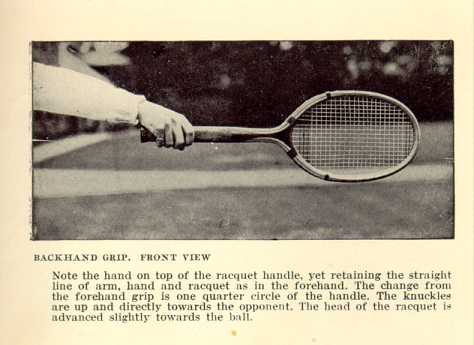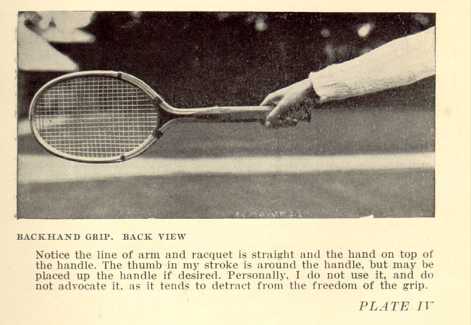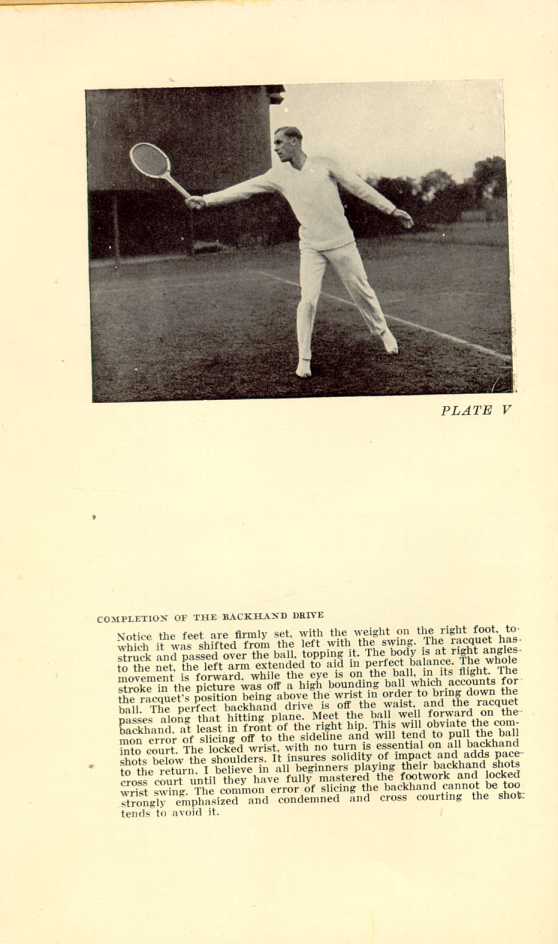| CHAPTER II THE DRIVE The Art of Lawn Tennis | ||
2. CHAPTER II
THE DRIVE
THE forehand drive is the opening of every offensive in tennis, and, as such, should be most carefully studied. There are certain rules of footwork that apply to all shots. To reach a ball that is a short distance away, advance the foot that is away from the shot and thus swing into position to hit. If a ball is too close to the body, retreat the foot closest to the shot and drop the weight back on it, thus, again, being in position for the stroke. When hurried, and it is not possible to change the foot position, throw the weight on the foot closest to the ball.
The receiver should always await the service facing the net, but once the serve is started on the way to court, the receiver should at once attain the position to receive it with the body at right angles to the net.
The forehand drive is made up of one continuous swing of the racquet that, for the purpose of analysis, may be divided into three parts:
- 1. The portion of the swing behind the body, which determines the speed of the stroke.
- 2. That portion immediately in front of the body
which determines the direction and, in conjunction with weight shift from one foot to the other, the pace of the shot.34
- 3. The portion beyond the body, comparable to the golfer's "follow through," determines spin, top or slice, imparted to the ball.
All drives should be topped. The slice shot is a totally different stroke.
To drive straight down the side-line, construct in theory a parallelogram with two sides made up of the side-line and your shoulders, and the two ends, the lines of your feet, which should, if extended, form the right angles with the side-lines. Meet the ball at a point about 4 to 4½ feet from the body immediately in front of the belt buckle, and shift the weight from the back to the front foot at the moment of striking the ball. The swing of the racquet should be flat and straight through. The racquet head should be on a line with the hand, or, if anything, slightly in advance; the whole arm and the racquet should turn slightly over the ball as it leaves the racquet face and the stroke continue to the limit of the swing, thus imparting top spin to the ball.
The hitting plane for all ground strokes should be between the knees and shoulders. The most favourable plane is on a line with the waist.
In driving across the court from the right (or No. 1) court, advance the L or front foot slightly towards the side-line and shift the weight a fraction
Never step away from the ball in driving cross court. Always throw your weight in the shot.
The forehand drive from the No. 2 (or left) court is identically the same for the straight shot down your opponent's forehand. For the cross drive to his backhand, you must conceive of a diagonal line from your backhand corner to his, and thus make your stroke with the footwork as if this imaginary line were the side-line. In other words, line up your body along your shot and make your regular drive. Do not try to "spoon" the ball over with a delayed wrist motion, as it tends to slide the ball off your racquet.
All drives should be made with a stiff, locked wrist. There is no wrist movement in a true drive. Top spin is imparted by the arm, not the wrist.
The backhand drive follows closely the principles of the forehand, except that the weight shifts a moment sooner, and the R or front foot should always be advanced a trifle closer to the side-line than the L so as to bring the body clear of the swing. The ball should be met in front of the right leg, instead of the belt buckle, as the great tendency in backhand shots is to slice them out of the side-line, and this will pull the ball cross court, obviating this
I strongly urge that no one should ever favour one department of his game, in defence of a weakness. Develop both forehand and backhand, and do not "run around" your backhand, particularly in return of service. To do so merely opens your court. If you should do so, strive to ace your returns, because a weak effort would only result in a kill by your opponent.
Do not develop one favourite shot and play nothing but that. If you have a fair cross-court drive, do not use it in practice, but strive to develop an equally fine straight shot.
Remember that the fast shot is the straight shot. The cross drive must be slow, for it has not the room owing to the increased angle and height of the net. Pass down the line with your drive, but open the court with your cross-court shot.
Drives should have depth. The average drive should hit behind the service-line. A fine drive should hit within 3 feet of the base-line. A cross-court drive should be shorter than a straight drive, so as to increase the possible angle. Do not always play one length drive, but learn to vary your distance according to your man. You should drive deep against a base-liner, but short against a net player, striving to drop them at his feet as, he comes in.

PLATE IV: BACKHAND GRIP. FRONT VIEW:
Note the hand on top of the racquet handle, yet retaining the straight
line of arm, hand and racquet Is in the forehand. The change from
the forehand grip is one quarter circle of the handle. The knuckles
are up and directly towards the opponent. The head of the racquet is
advanced slightly towards the ball.
[Description: photograph of BACKHAND GRIP. FRONT VIEW]

PLATE IV: BACKHAND GRIP. BACK VIEW:
Notice the line of arm and racquet is straight and the hand on top of
the handle. The thumb in my stroke is around the handle, but may be
placed up the handle if desired. Personally, I do not use it, and do
not advocate it, as it tends to detract from the freedom of the
grip.
[Description: photograph of PLATE IV: BACKHAND GRIP. BACK VIEW:
]
PLATE V:
COMPLETION OF THE BACKHAND DRIVE:
Notice the feet are firmly set, with the weight on the right foot, to
which it was shifted from the left with the swing. The racquet has
struck and passed over the ball, topping it. The body is at right angles
to the net, the left arm extended to aid in perfect balance. The whole
movement is forward, while the eye is on the ball, in its flight. The
stroke in the picture was off a high bounding ball which accounts for
the racquet's position being above the wrist in order to bring down the
ball. The perfect backhand drive is off the waist, and the racquet
passes along that hitting plane. Meet the ball well forward on the
backhand, at least in front of the right hip. This will obviate the common
error of slicing off to the sideline and will tend to pull the ball,
into court. The locked wrist, with no turn is essential on all backhand
shots below the shoulders. It insures solidity of impact and adds pace
to the return. I believe in all beginners playing their backhand shots
cross court until they have fully mastered the footwork and locked
wrist swing. The common error of slicing the backhand cannot be too
strongly emphasized and condemned and cross courting the shot
tends to avoid it.
[Description:
Photograph of COMPLETION OF THE BACKHAND DRIVE
]
Never allow your opponent to play a shot he likes if you can possibly force him to one he dislikes.
Again I urge that you play your drive:
1. With the body sideways to the net.
2. The swing flat, with long follow through.
3. The weight shifting just as the ball is hit.
Do not strive for terrific speed at first. The most essential thing about a drive is to put the ball in play. I once heard William A. Larned remark, when asked the most important thing in tennis, "Put the ball over the net into the other man's court." Accuracy first, and then put on your speed, for if your shot is correct you can always learn, to hit hard.
| CHAPTER II THE DRIVE The Art of Lawn Tennis | ||